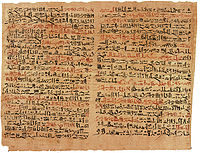Wikipedia:Featured picture candidates/Edwin Smith Papyrus v2.jpg
Edwin Smith surgical papyrus, plate VI and VII[edit]


- Reason
- This unique, important document demonstrates the sophistication of ancient Egyptian medicine. Image is large, and it is very easy to study the hieratic characters (a type of cursive hieroglyphs) and the scribe's handwriting, which is of good quality. The document is not usually on public display.
- Proposed caption
- The Edwin Smith papyrus is the world's oldest surviving surgical document.[1] Written in hieratic script in ancient Egypt around 1600 B.C., the text describes anatomical observations and the examination, diagnosis, treatment, and prognosis of 48 types of medical problems in exquisite detail. Among the treatments described are closing wounds with sutures, preventing and curing infection with honey and moldy bread, stopping bleeding with raw meat, and immobilization of head and spinal cord injuries. Translated in 1930, the document reveals the sophistication and practicality of ancient Egyptian medicine. Plate 6 and 7 of the papyrus, pictured here, discuss facial trauma.
- Articles this image appears in
- Edwin Smith papyrus, Ancient Egypt, History of scientific method, Medical literature
- Creator
- MickWest
- Support as nominator Jeff Dahl 23:21, 3 October 2007 (UTC)
- Support edit 1 Good image, interesting subject.
What are ghost document edges and unexplained lines at the very bottom of the image, below the papyrus itself? Are they artifacts of some kind that should be removed?Enuja (talk) 02:22, 4 October 2007 (UTC) Well, I'm happy to see the artifacts gone, although I still wish I knew what they where! Enuja (talk) 03:43, 4 October 2007 (UTC)
- Cleaned up in version 2. Jeff Dahl 02:56, 4 October 2007 (UTC)
- Support either Very interesting and historic image. -- Grandpafootsoldier 08:35, 4 October 2007 (UTC)
- Support, great scan. I would recommend fixing the caption to point out that this image depicts plates 6 and 7 of a longer document. (Any particular reason to select these plates, as opposed to others?) Spikebrennan 14:13, 4 October 2007 (UTC)
- I added a bit at the end of the caption, hope this is satisfactory. This section is one that is in the best condition; often the very beginning and end of a papyrus scroll suffer the most damage due to wear and tear. Interestingly, for some of the most traumatic injuries when death will be certain, the document instructs the physician not to even treat the patient, possibly to protect the physician's reputation! Reading the translation produced in 1930 is amazing, though a more modern translation is available from University of Chicago's Oriental Institute (1991). Jeff Dahl 17:27, 4 October 2007 (UTC)
- Support--Mbz1 16:31, 4 October 2007 (UTC)
- Support — Fantastic quality. ♠ SG →Talk 04:26, 5 October 2007 (UTC)
Promoted Image:Edwin Smith Papyrus v2.jpg MER-C 05:38, 11 October 2007 (UTC)
